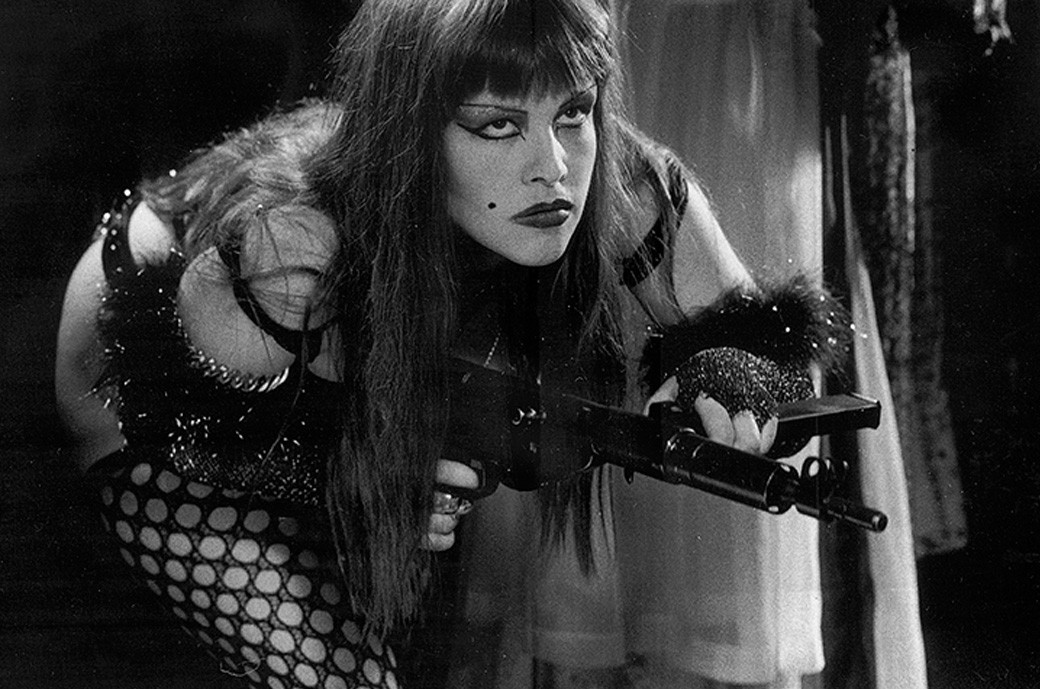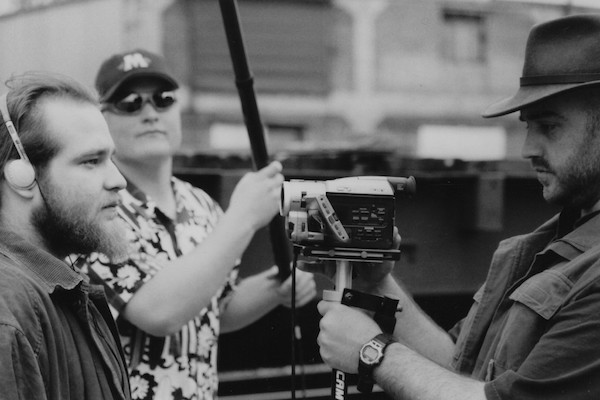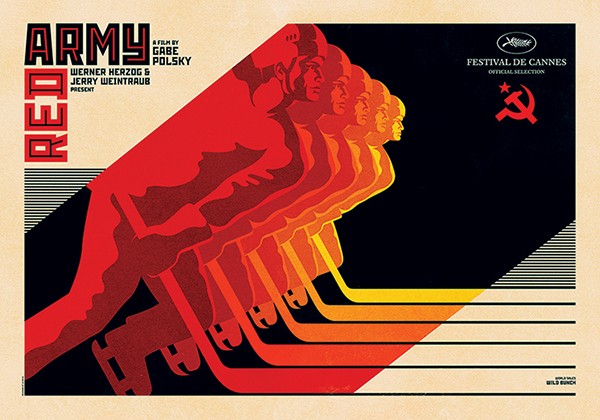Thank you to everyone who voted in our Best of Indie Memphis poll! We had many different, varied responses going way back into Indie Memphis’ twenty year history. I had originally wanted to do a top ten list, but there were so many ties that I would have had 18 films in the Hometowner top ten, and five films tied for first place in the general category. So instead, I’ll be doing a chronological countdown of the poll’s top vote-getters, staring from the beginning of the festival and moving to the present day, in a series of blog posts called Indie Memphis’ Greatest Hits. Let’s get this party started!
Superstarlet A.D. (1999)

In the beginning, before there was an Indie Memphis or a digital revolution, there was John Michael McCarthy. The renegade punk from Tupelo, Mississippi moved heaven and earth to bring his psychotronic vision to life on film—actual film, not digital video! Superstarlet A.D., which won the festival feature competition in 1999, its second year, is the apotheosis of McCarthy’s 90s filmography. It’s a heady brew of garage rock (Memphis punk goddess Alicja Trout is one of the stars), grindhouse exploitation, and The Feminine Mystique. McCarthy transformed late 90s urban blight into a post-apocalyptic hellscape populated by tribes of feral women dead set on taking revenge on the men who broke the world.
Today, McCarthy continues to make films and comics, and is a leading force for historical preservation in the Bluff City. His documentary Destroy Memphis depicts the years-long struggle to save the Zippin Pippin from destruction, and he is currently working on a full sized bronze statue of Johnny Cash.
Indie Memphis’ Greatest Hits 1: Machine Gun Babes, The P&H, and Digital Rebels
The Poor And Hungry (2000)

Eric Tate, Seth Hagee, and Craig Brewer on the set of The Poor and Hungry.
In 2000, a Barnes & Noble bookstore clerk named Craig Brewer fired a shot heard round the world. Made with money left to him when his father unexpectedly passed away, Brewer’s The Poor and Hungry was named for the P&H Cafe, the midtown beer joint where Brewer wrote. It was not the first time he had tried to make a film, but thanks to the then cutting-edge digital video technology that allowed him to record DVD-quality video and edit on a desktop computer, it was the first time he succeeded. In the 1970s, Francis Ford Coppola had said that film would not be a truly democratic medium until a poor girl in Iowa could make one as easily as she could write a book. Brewer was the fulfillment of that prophecy, and his film went on to win awards at not only the Indie Memphis and Nashville Film Festivals, but also the Hollywood Film Festival. Five years later, Brewer brought home Oscar gold to Memphis with Hustle & Flow. Today, he is a writer and director for Empire, one of the most successful shows on television. You Look Like, the comedy game show he is producing, will premiere at Indie Memphis 2017. It was filmed on location at the P&H.
“I think what I’m most proud of, is that there were a lot of filmmakers in town who had their own identity, and their own desire to make films, and they would have probably done it anyway,” says Brewer. “But I do think that they watched The Poor and Hungry, and the swell of excitement around it, and realized that it was more doable than they thought. ‘I know actors just like that in town! I know those locations! I have a better camera than this movie had! I spent more money on lights than this movie had!’ But this movie did a lot with very few tools. At the time, filmmaking was very daunting because of the cost and how hard technically it was to pull off on film. There were a lot of local would-be filmmakers who saw it and thought, ‘It’s time.’”
Indie Memphis’ Greatest Hits 1: Machine Gun Babes, The P&H, and Digital Rebels (2)
Blue Citrus Hearts (2002)

In the Memphis of the early twenty first century, the epicenter of the revolution was the Digital Media Co-Op. Located in the basement of the First Congregational Church on Cooper, the Co-Op was founded by Brandon Hutchinson and Morgan Jon Fox. Fox, a Memphis native and White Station High School grad, had done a stint at a film school in New Hampshire before dropping out and returning to Memphis to find his own way. Members of the Co-Op pooled their resources and shared their knowledge. They learned together, and their experimental short films dominated the Indie Memphis Hometowner category for years. Blue Citrus Hearts was Fox and the Co-Op’s first attempt at a feature film, and it paid off spectacularly. The largely improvised story of young gay and misfit kids trying to cope in a closeted and repressive South combined the unflinching neorealism of Antonioni with the austerity of the Dogma ’95 movement—call it Memphis, Open City. It’s an emotionally wrenching ride. But the big payoff came at the end, where Fox’s camera accidentally captured an actual shooting star above the heads of his characters sharing their first kiss on the roof of the Tennessee Brewery.
Indie Memphis’ Greatest Hits 1: Machine Gun Babes, The P&H, and Digital Rebels (4)
Automusik Can Do No Wrong (2004)

Automusik at Sun Studios
One of the people inspired by Craig Brewer and the Media Co-Op was me. I had written my first feature film in 1994, but our attempts to produce it in the pre-digital era had failed. My friend and co-conspirator Steve Stanley, along with Chris Triko, Talbot Fields, and many others, discovered digital video tech and made two films around the turn of the century: Slick Lilly vs. The Grand Canyon and Six Days in the Life of Mims, both of which screened successfully at Indie Memphis. I had acted and crewed on both pictures, and caught the filmmaking bug bad. While Mims was in post production, I was eager to do my own thing. I was a fan of the synth pop parody band Automusik, which was baffling crowds all over Memphis. After one particularly crazed performance, I bought Automusik mastermind Scott Moss a drink at the bar and proposed doing a Spinal Tap-style mockumentary together. We enlisted Pritchard Smith, whose documentary short “$200 On eBay” had won at Indie Memphis the year before, and nine months later we won Best Hometowner Feature at Indie Memphis. Today, we’re still at it. Smith is a director/producer who helped found Vice’s video operation. His documentary The Invaders sold out opening night at Indie Memphis last year. I still believe what I told then-Memphis Flyer Film Editor Chris Herrington in a November, 2004 interview: “Half of the director’s job is to choose the people you want to work with and let them do their job.”
Here’s the most famous sequence from Automusik Can Do No Wrong, in which we recreated the climax of Purple Rain—in German.
AUTOMUSIK CAN DO NO WRONG clip – "The Machine" & "The Hammer Song" from oddly buoyant productions on Vimeo.
Indie Memphis’ Greatest Hits 1: Machine Gun Babes, The P&H, and Digital Rebels (5)
Cocaine Cowboys (2006)

As you can read in my Memphis Magazine article on the history of the festival, Indie Memphis was founded as a place for local filmmakers to show their work. In the early days, there was not much content from outside the Memphis metro area. But as the festival matured and expanded, that changed. By the middle of the 00’s, it was the place to go to see cutting-edge films that would never otherwise get a theatrical run in the Bluff City. One of the first films to screen at Indie Memphis that broke out and attracted a wider audience was Billy Corben’s Cocaine Cowboys. Corben’s film was ideal for Indie Memphis. It took a controversial subject matter and dove into it from a regional perspective. Corben is from Miami, and his intricate history of Florida drug smuggling puts heavy emphasis on both the price the city paid and the unexpected ways the era built contemporary Florida. Months after it screened at Indie Memphis, Cocaine Cowboys got a wide distribution and spawned two sequels. Today, it’s a staple on cable TV, and Corben has had a career making ESPN’s documentary series 30 for 30.
Indie Memphis’ Greatest Hits 1: Machine Gun Babes, The P&H, and Digital Rebels (3)
Tune in tomorrow for part 2. You can also check out the entire history of Indie Memphis as told through the collected programs in this slideshow set over at Memphis Magazine.
